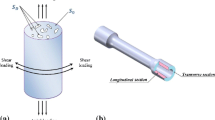Conclusions
-
1.
The anisotropy of the mechanical properties of extruded duralumin bars depends on the structural condition and the type of hardening heat treatment.
-
2.
The reasons for the anisotropy of different strength characteristics of naturally aged aluminum alloys are not the same. The anisotropy of the yield strength depends mainly on the presence of a preferential crystallographic orientation in semifinished products worked under pressure (primary anisotropy) and the oriented Guinier-Preston zones formed in the process of natural aging of textured meterial (secondary anisotropy).
The anisotropy of the ultimate strength and true strength depends mainly on the mechanical texture.
-
3.
It was shown that it is possible to control the anisotropy of the yield strength by changing the preferential orientation of the material, selecting the combination of orientations ensuring the desired value of the anisotropy.
Similar content being viewed by others
Literature cited
H. Unkel, Metallwirtschaft,19, No. 3 (1940).
D. Wilson, Sheet Metal Ind.,39, No. 428 (1962).
V. P. Kozlovskaya, in: Investigations of Nonferrous Alloys [in Russian], No. 2; Izd. AN SSSR (1960).
V. I. Dobatkin, in: Metal Science of Light Alloys [in Russian], Nauka, Moscow (1965).
I. P. Kudryavtsev, Texture in Metals and Alloys [in Russian], Metallurgiya, Moscow (1965).
K. Dies, Aluminium,41, No. 12 (1965).
P. G. Miklyaev and L. Ya. Volozneva, in: Technology of Light Alloys [in Russian], No. 2 (1969).
E. Shmidt and V. Boas, Plasticity of Crystals, Particularly of Metals [Russian translation], GONTI MKTP SSSR (1938).
D. I. Lainer and L. D. Kharitonova, Trudy Inst. Giprotsvetmetobrabotka, No. 18 (1960).
M. Renouard and J. Bresson, Rev. de l'Aluminium,246 (1957).
I. I. Novikov and M. V. Zakharov, Heat Treatment of Metals and Alloys [in Russian], Metallurgizdat, Moscow (1962).
A. Guinier, Heterogeneous Metallic Solid Solutions [Russian translation], IL, Moscow (1964).
Additional information
Translated from Metallovedenie i Termicheskaya Obrabotka Metallov, No. 7, pp. 37–41, July, 1970.
Rights and permissions
About this article
Cite this article
Volozneva, L.Y., Miklyaev, P.G. Anisotropy of the strength characteristics of aluminum alloys. Met Sci Heat Treat 12, 586–590 (1970). https://doi.org/10.1007/BF00664954
Issue Date:
DOI: https://doi.org/10.1007/BF00664954




